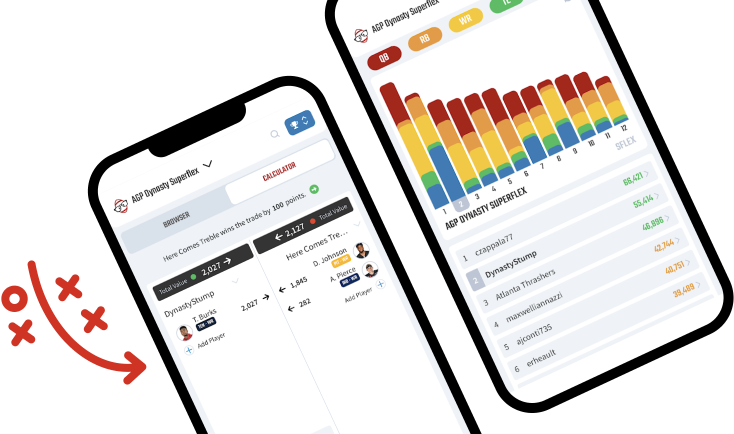Welcome to the Positional Matchups introduction. Here, I will discuss how I derive positional matchups from fantasy points allowed and, ultimately, how to use them. In the weekly article, I will explain which teams give up fantasy points to what positions. I will then highlight potentially exploitable matchups and trends. I’ll provide a full table for upcoming matchups every week in a nice and easy-to-apply format. So, let’s get to it.
To understand things, it’s best to start with fantasy points allowed. The concept is easy enough. In Week 5, the Packers allowed Raiders running backs to score a total of 14.3 PPR fantasy points. On its own, this number is rather meaningless because we don’t know how much Raiders running backs typically score. If they typically score 20 points, we would consider this a poor outing, and if they typically score 10 points, then this could be viewed as a success. This is where the “Schedule-Adjusted” portion of the report comes into play.
Over the first four weeks, Raiders running backs have scored an average of 11.45 points per game, which means they outperformed expectations this past week. Another way to put this is that the Packers allowed 2.85 points over average this week. Through the magic of spreadsheets, I calculate this for every team and every position each week and compile that into Schedule-Adjusted Fantasy Points Allowed.
With the theorycraft over, we can start to use this information. Points-allowed tables are nothing new and can be found all over. Schedule-adjusted points allowed, like we are doing, are a bit harder to calculate, so it’s not as widespread. Let’s take a look at the table for the first five weeks.
Fantasy Points Allowed
There is a pretty widespread when it comes to points allowed, and we can use this information to our benefit. It’s straightforward enough for quarterbacks: if your QB plays the Chargers, you can expect 4.7 extra points that week. But there are still a few issues. One, this can still be influenced by the schedule.
Let’s say Team A plays opponents whose RBs average 20 points a game, but Team A allows 25 points that week. Then let’s say Team B plays opponents whose RBs average 5 points a game, but Team B allows 10 points. Both would show up as 5 points allowed over average despite Team B allowing double the average points, but Team A only allowed a quarter over average.
Another shortcoming is that outside of single-starter positions, it is difficult to figure out how these points will be dispersed across a team. A team’s RBs might score 6 points extra in a matchup, but it’s unlikely you know your player’s usual share off the top of your head. We can make this easier to use by converting it to a percentage.
Percentage of Fantasy Points Allowed
Now, here’s something we can use. Not only will this represent the schedule in a more unbiased fashion, but it’s far easier to apply. Let’s look at an example of Dameon Pierce. Over the first five weeks, Dameon Pierce has scored 6.7, 5.5, 14.9, 11.8, and 9.2 PPR points per game. If you have extraordinary mental math capabilities, you’d know that is a 9.6 points per game average. I do not. I would look at those numbers and ballpark him around 10 points a game. Next week, he plays the Saints. According to the above chart, the Saints allow 23% fewer fantasy points to running backs compared to their average. Again, in the interest of simplicity, I would round this to about 25%. If his average is 10 points and he will score 25% less, we can estimate that he’ll total about 7.5 PPR points this upcoming week.
Congratulations, you just created your first player projection! It might be rough, and we might be a little liberal with the rounding, but we’re talking about the NFL. We’re already knee-deep into bad statistical practices compared to the real mathematicians out there. That’s okay, though, because we’re not predicting the next big market crash or the trajectory of an asteroid. We’re just trying to beat Matt from Engineering, who sniped Zay Flowers from you in the draft.
But we aren’t done just yet. How can we improve this even further? Simple, cross-reference it with the schedule so you don’t need to remember the 16ish matchups every week. It’s relatively simple compared to the other formulas but makes it that much easier to set lineups. So, without further ado, I present the finished product.
The Percentage of Schedule-Adjusted Fantasy Points Allowed! I once dreamt of calling it POSAFPA (pronounced poh-saf-puh), but I recognize that we are already inundated with acronyms. That said, it’s a good unique identifier and search term. For simplicity’s sake, though, I will refer to it as Positional Matchups from here on out.
Positional Matchups: The Final Product
It’s the same info as the previous table but easier to use (have you caught on to the theme yet). Now that I’ve given you a nice, easy-to-use tool, let me explain how you should use it.
First things first, this isn’t an end-all-be-all tool. While this takes into account positional matchups, there are other things to consider when setting lineups. My lineup decisions are typically a combination of player volume, positional matchup, the Vegas over/under on the game, the implied game script, the weather, if applicable, and a hefty dose of information from people smarter than I. This is, however, a significant component and most often my decision-maker when staring down two similar volume options. For the other info mentioned, I recommend looking at our other Sit-Start articles here.
There are two other things I’d like to note and they both relate to how the NFL uses position designations. First is that players with dual or nontraditional roles are not as influenced by matchups. Running backs used primarily as pass catchers are one example. Wide receivers who get carries and rushing QBs are also less susceptible to negative matchups.
The second is that while WR is a single position, it is, in fact, several roles. If a wide receiver primarily plays on the perimeter and faces a shutdown corner, they might be in for a rough matchup, but the slot receiver might fare just fine. Unfortunately, we are simply limited by the information available to us. Pairing positional matchups with shadow corner reports can give you insight into which players may be the exception that week.
Examples
I’ll give an example of what this is good for. Let’s say you’re looking to fill your flex position and deciding between DK Metcalf (WR-SEA) or Brian Robinson (RB-WAS). For DK Metcalf, find SEA in the first column, then follow that row over to the WR column, and you’ll see his positional matchup is 10%. That’s a moderately good matchup. Next for Robinson, find WAS in the first column and follow that row to the RB column, and you’ll see his matchup as -32%, which is a strongly negative matchup. Given both players are averaging just over 14 PPR points per game, I would be leaning DK Metcalf here.
So there you have it. Look out for the weekly report to include matchups to target/avoid. I will also highlight team trends for future matchups and provide a few examples of players in borderline situations. Until then, good luck.









3 Responses
So, if I am understanding this correctly, the numbers say that Demmondre Lenoir DB SF would be a better start than Trent McDuffie DB KC?
Interesting read…what is your twitter handle so I can follow your content?
@moncalff
Thanks for the reminder to mention it in my articles.